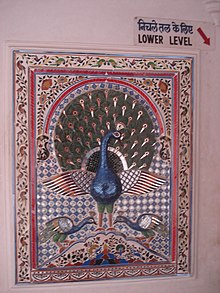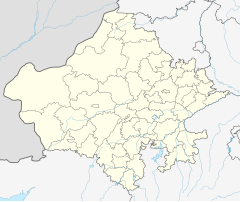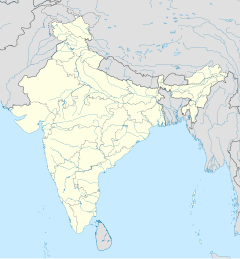Bagore-ki-Haveli: Difference between revisions
Shyamsunder (talk | contribs) added Category:Buildings and structures in Udaipur using HotCat |
Undid revision 1254158892 by 59.184.132.97 (talk) |
||
| (23 intermediate revisions by 18 users not shown) | |||
| Line 1: | Line 1: | ||
{{Use dmy dates|date=April 2017}} |
|||
[[File:Bagore ki Haveli, Rajasthan.jpg|thumb|210px|Museum at Bagore ki Haveli, Rajasthan]] |
|||
{{Use Indian English|date=April 2017}} |
|||
'''Bagore-ki-Haveli''' is a [[haveli]] in [[Udaipur]] in [[Rajasthan]] state in [[India]]. It is right on the waterfront of Lake Pichola at Gangori Ghat. Amir Chand Badwa, the Prime Minister of [[Mewar]], built it in the eighteenth century. |
|||
{{Infobox historic site |
|||
| name = Bagore ki Haveli |
|||
| native_name = |
|||
| native_language = |
|||
| native_name2 = |
|||
| native_language2 = |
|||
| native_name3 = |
|||
| native_language3 = |
|||
| other_name = |
|||
| image = Bagore ki Haveli, Rajasthan.jpg |
|||
| image_size = |
|||
| alt = |
|||
| caption = Museum at Bagore ki Haveli |
|||
| locmapin = India Rajasthan#India |
|||
| map_relief = |
|||
| map_width = |
|||
| map_caption = Haveli in Udaipur |
|||
| map_dot_mark = |
|||
| coordinates = <!-- {{Coord}} --> {{Coord|24.5796687|N|73.6800357|E|display=title}} |
|||
| gbgridref = |
|||
| type = |
|||
| etymology = |
|||
| location = |
|||
| nearest_city = |
|||
| area = |
|||
| elevation = |
|||
| height = |
|||
| beginning_label = |
|||
| beginning_date = |
|||
| formed = |
|||
| founded = |
|||
| founder = |
|||
| built = ~ 1751 to 1778 CE |
|||
| built_for = Amarchand Badwa |
|||
| original_use = [[haveli]] |
|||
| demolished = |
|||
| rebuilt = |
|||
| restored = |
|||
| restored_by = |
|||
| current_use = |
|||
| architect = |
|||
| sculptor = |
|||
| architecture = |
|||
| visitors_num = |
|||
| visitors_year = |
|||
| visitors_ref = |
|||
| governing_body = |
|||
| owner = |
|||
| website = |
|||
| designation1 = |
|||
| designation1_offname = |
|||
| designation1_type = |
|||
| designation1_criteria = |
|||
| designation1_date = |
|||
| delisted1_date = |
|||
| designation1_partof = |
|||
| designation1_number = |
|||
| designation1_free1name = |
|||
| designation1_free1value = |
|||
| designation1_free2name = |
|||
| designation1_free2value = |
|||
| designation1_free3name = |
|||
| designation1_free3value = |
|||
| designation2 = |
|||
| designation2_offname = |
|||
| designation2_type = |
|||
| designation2_criteria = |
|||
| designation2_date = |
|||
| delisted2_date = |
|||
| designation2_partof = |
|||
| designation2_number = |
|||
| designation2_free1name = |
|||
| designation2_free1value = |
|||
| designation2_free2name = |
|||
| designation2_free2value = |
|||
| designation2_free3name = |
|||
| designation2_free3value = |
|||
| designation3 = |
|||
| designation3_offname = |
|||
| designation3_type = |
|||
| designation3_criteria = |
|||
| designation3_date = |
|||
| delisted3_date = |
|||
| designation3_partof = |
|||
| designation3_number = |
|||
| designation3_free1name = |
|||
| designation3_free1value = |
|||
| designation3_free2name = |
|||
| designation3_free2value = |
|||
| designation3_free3name = |
|||
| designation3_free3value = |
|||
| designation4 = |
|||
| designation4_offname = |
|||
| designation4_type = |
|||
| designation4_criteria = |
|||
| designation4_date = |
|||
| delisted4_date = |
|||
| designation4_partof = |
|||
| designation4_number = |
|||
| designation4_free1name = |
|||
| designation4_free1value = |
|||
| designation4_free2name = |
|||
| designation4_free2value = |
|||
| designation4_free3name = |
|||
| designation4_free3value = |
|||
| designation5 = |
|||
| designation5_offname = |
|||
| designation5_type = |
|||
| designation5_criteria = |
|||
| designation5_date = |
|||
| delisted5_date = |
|||
| designation5_partof = |
|||
| designation5_number = |
|||
| designation5_free1name = |
|||
| designation5_free1value = |
|||
| designation5_free2name = |
|||
| designation5_free2value = |
|||
| designation5_free3name = |
|||
| designation5_free3value = |
|||
}} |
|||
'''Bagore-ki-Haveli''' is a [[haveli]] in [[Udaipur]] in [[Rajasthan]] state in [[India]]. It is right on the waterfront of [[Lake Pichola]] at [[Gangaur Ghat|Gangori Ghat]]. Amar Chand Badwa, the Prime Minister of [[Mewar]], built it in the eighteenth century. |
|||
==Overview== |
==Overview== |
||
| Line 6: | Line 127: | ||
==History== |
==History== |
||
Shri Amarchand Badwa, who was the Prime Minister of Mewar from 1751 to 1778, throughout the reigns of Maharanas Pratap Singh II, Raj Singh II, Ari Singh, and Hamir Singh respectively, built this haveli. Following the death of Amarchand, the edifice came under the domain of the Mewari |
Shri Amarchand Badwa, a [[Sanadhya Brahmin]] who was the Prime Minister of Mewar from 1751 to 1778, throughout the reigns of Maharanas Pratap Singh II, Raj Singh II, Ari Singh, and Hamir Singh respectively, built this haveli. Following the death of Amarchand, the edifice came under the domain of the Mewari royal family and Bagore-ki-Haveli was occupied by Nath Singh, a relative of the then maharana. In 1878, the natural father of Sajjan Singh, Maharaj Shakti Singh of Bagore extended the haveli and built the triple-arched gateway, and the property remained in the possession of Mewar State until 1947. After Independence, the Government of Rajasthan used the buildings for housing Government employees, but, as with other nationalised properties, where there was nobody with a vested interest in the standards of maintenance, damage and neglect went unchecked, and for almost forty years, the haveli's condition deteriorated to a deplorable extent. The Government was eventually persuaded to relinquish their hold on the haveli and in 1986; it was handed over to the West Zone Cultural Centre. |
||
[[File:Entrance court at Bagore-ki-Haveli.jpg|thumb|Entrance court at Bagore-ki-Haveli]] |
[[File:Entrance court at Bagore-ki-Haveli.jpg|thumb|Entrance court at Bagore-ki-Haveli]] |
||
==Restoration Work== |
==Restoration Work== |
||
The West Zone Cultural Centre planned to renovate the haveli into a museum. Originally, the idea was to represent the culture of Maharashtra, Goa, Gujarat and Rajasthan, the West Zone States, in the proposed museum. However, seeing that the Haveli was an architectural museum by itself, owing to typical and charming architectural style, it was decided that it would be preserved as a museum of |
The West Zone Cultural Centre planned to renovate the haveli into a museum. Originally, the idea was to represent the culture of Maharashtra, Goa, Gujarat and Rajasthan, the West Zone States, in the proposed museum. However, seeing that the Haveli was an architectural museum by itself, owing to typical and charming architectural style, it was decided that it would be preserved as a museum of Mewar's aristocratic culture. |
||
[[File:Glass window at Bagore-ki-Haveli.JPG|thumb|Glass window at Bagore-ki-Haveli]] |
[[File:Glass window at Bagore-ki-Haveli.JPG|thumb|Glass window at Bagore-ki-Haveli]] |
||
To provide the same royal look, experts and members of the |
To provide the same royal look, experts and members of the royal family were consulted. The Haveli was restored primarily using local and traditional skills and materials including [[lakhori bricks]] and [[lime mortar]]. Several murals done in [[araish]] in the 18th and 19th century were uncovered, and many doors, windows and perforated screens were repaired or replaced. |
||
==Present Status== |
==Present Status== |
||
| Line 22: | Line 143: | ||
[[File:Peacock in glass mosaic.jpg|thumb]] |
[[File:Peacock in glass mosaic.jpg|thumb]] |
||
The Chambers of the Royal Ladies still bear fine frescoes of the Mewari style and there are glorious coloured-glass windows in some of the rooms as well as two peacocks made with coloured glass mosaics that display the superb skills of the finest craftsmanship. |
The Chambers of the Royal Ladies still bear fine frescoes of the Mewari style and there are glorious coloured-glass windows in some of the rooms as well as two peacocks made with coloured glass mosaics that display the superb skills of the finest craftsmanship. |
||
Unique symbols of the [[Rajput]] clan, such as jewellery boxes, dice-games, hukkas, pan boxes, nut crackers, hand fans, rose water sprinklers, copper vessels and other items are also on display here. |
Unique symbols of the [[Rajput]] clan, such as jewellery boxes, dice-games, hukkas, pan boxes, nut crackers, hand fans, rose water sprinklers, copper vessels and other items are also on display here. |
||
In the evening, the haveli lightens and stages enjoyable performance of traditional dance and music of Rajasthan. The haveli looks marvelous with glowing lights in the night. Bagore Ki Haveli is a perfect place to explore the ancient architecture and life style of the royal family. |
In the evening, the haveli lightens and stages enjoyable performance of traditional dance and music of Rajasthan. The haveli looks marvelous with glowing lights in the night. Bagore Ki Haveli is a perfect place to explore the ancient architecture and life style of the royal family. |
||
==References== |
==References== |
||
{{commonscat}} |
{{commonscat|Bagore-ki-Haveli}} |
||
* [ |
* [https://www.scribd.com/doc/40188164/Udaipur-Settlement-Study Udaipur Settlement Study] |
||
{{Udaipur}} |
|||
{{coord missing|Rajasthan}} |
|||
{{DEFAULTSORT:Bagore-Ki-Haveli}} |
{{DEFAULTSORT:Bagore-Ki-Haveli}} |
||
{{Udaipur}} |
|||
[[Category:Houses completed in the 18th century]] |
[[Category:Houses completed in the 18th century]] |
||
[[Category:Havelis]] |
[[Category:Havelis in India]] |
||
[[Category: |
[[Category:Tourist attractions in Udaipur]] |
||
[[Category:Visitor attractions in Udaipur]] |
|||
[[Category:Buildings and structures in Udaipur]] |
[[Category:Buildings and structures in Udaipur]] |
||
[[Category:Palaces in Udaipur]] |
|||
Latest revision as of 17:55, 29 October 2024
| Bagore ki Haveli | |
|---|---|
 Museum at Bagore ki Haveli | |
| Coordinates | 24°34′47″N 73°40′48″E / 24.5796687°N 73.6800357°E |
| Built | ~ 1751 to 1778 CE |
| Built for | Amarchand Badwa |
| Original use | haveli |
Bagore-ki-Haveli is a haveli in Udaipur in Rajasthan state in India. It is right on the waterfront of Lake Pichola at Gangori Ghat. Amar Chand Badwa, the Prime Minister of Mewar, built it in the eighteenth century.
Overview
[edit]The palace has over a hundred rooms, with displays of costumes and modern art. The glass and mirror in the interiors are Haveli work. It also preserves an example of Mewar painting on the walls of the Queen's Chamber. The two peacocks made from small pieces of colored glasses are examples of glasswork.
History
[edit]Shri Amarchand Badwa, a Sanadhya Brahmin who was the Prime Minister of Mewar from 1751 to 1778, throughout the reigns of Maharanas Pratap Singh II, Raj Singh II, Ari Singh, and Hamir Singh respectively, built this haveli. Following the death of Amarchand, the edifice came under the domain of the Mewari royal family and Bagore-ki-Haveli was occupied by Nath Singh, a relative of the then maharana. In 1878, the natural father of Sajjan Singh, Maharaj Shakti Singh of Bagore extended the haveli and built the triple-arched gateway, and the property remained in the possession of Mewar State until 1947. After Independence, the Government of Rajasthan used the buildings for housing Government employees, but, as with other nationalised properties, where there was nobody with a vested interest in the standards of maintenance, damage and neglect went unchecked, and for almost forty years, the haveli's condition deteriorated to a deplorable extent. The Government was eventually persuaded to relinquish their hold on the haveli and in 1986; it was handed over to the West Zone Cultural Centre.

Restoration Work
[edit]The West Zone Cultural Centre planned to renovate the haveli into a museum. Originally, the idea was to represent the culture of Maharashtra, Goa, Gujarat and Rajasthan, the West Zone States, in the proposed museum. However, seeing that the Haveli was an architectural museum by itself, owing to typical and charming architectural style, it was decided that it would be preserved as a museum of Mewar's aristocratic culture.
To provide the same royal look, experts and members of the royal family were consulted. The Haveli was restored primarily using local and traditional skills and materials including lakhori bricks and lime mortar. Several murals done in araish in the 18th and 19th century were uncovered, and many doors, windows and perforated screens were repaired or replaced.
Present Status
[edit]There are 138 rooms, as well as numerous corridors & balconies, courtyards and terraces. The interiors of the Haveli are embellished with intricate and fine mirror work. While strolling in the Haveli, you can also see the private quarters of the royal ladies, their bath rooms, dressing rooms, bed rooms, living rooms, worship rooms and recreation rooms.

The Chambers of the Royal Ladies still bear fine frescoes of the Mewari style and there are glorious coloured-glass windows in some of the rooms as well as two peacocks made with coloured glass mosaics that display the superb skills of the finest craftsmanship.
Unique symbols of the Rajput clan, such as jewellery boxes, dice-games, hukkas, pan boxes, nut crackers, hand fans, rose water sprinklers, copper vessels and other items are also on display here.
In the evening, the haveli lightens and stages enjoyable performance of traditional dance and music of Rajasthan. The haveli looks marvelous with glowing lights in the night. Bagore Ki Haveli is a perfect place to explore the ancient architecture and life style of the royal family.

